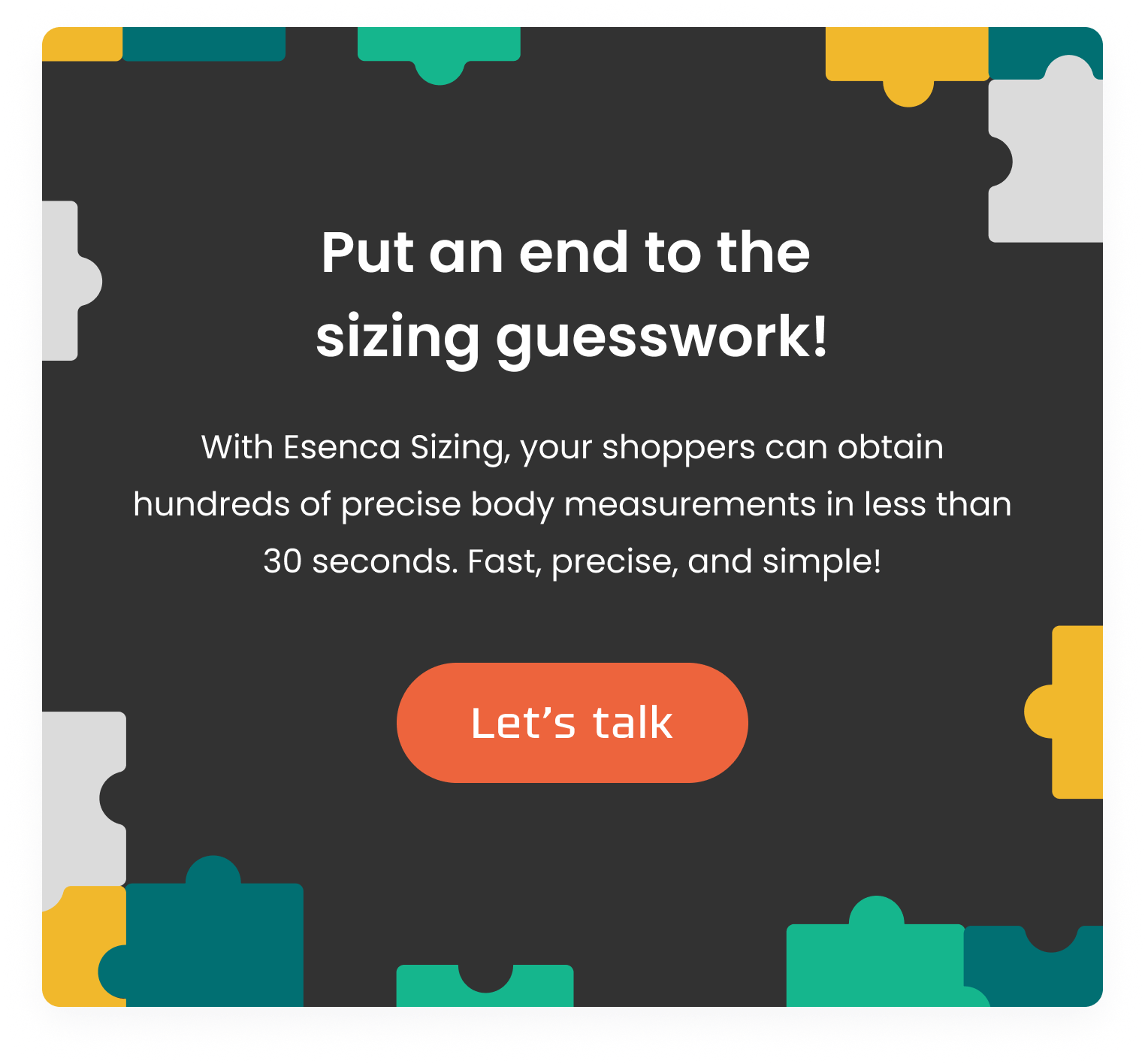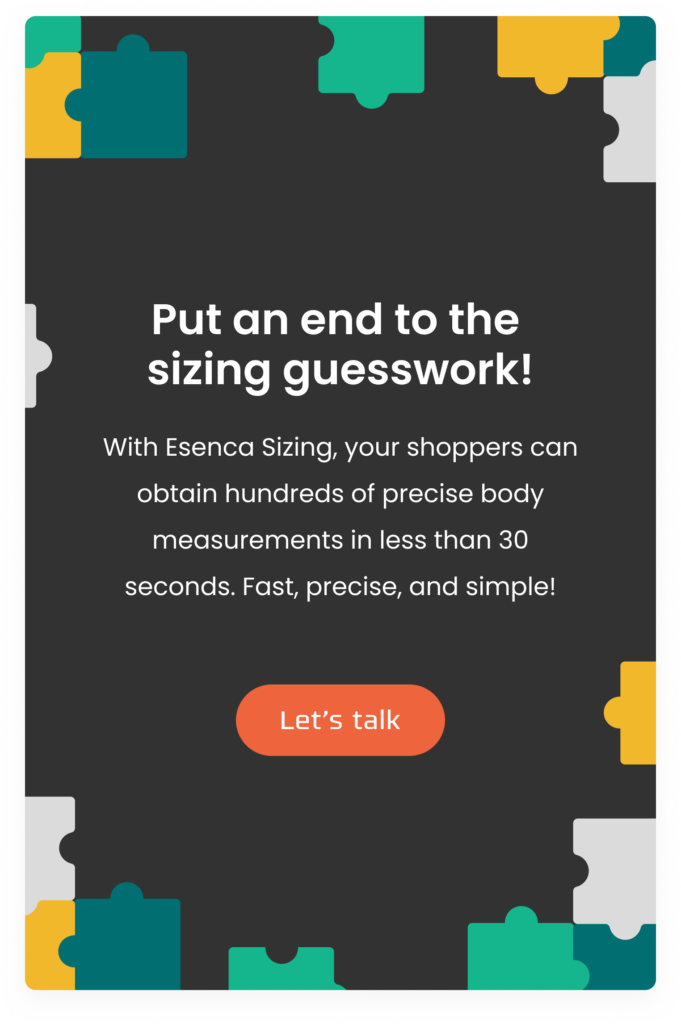
Fashion’s sizing problem runs much deeper than frustrated customers returning ill-fitting clothes. What looks like a simple shopping inconvenience has become an environmental disaster, with 67% of American women wearing size 44 or above yet struggling to find consistent fits across. This sizing chaos generates approximately 3.5 billion product returns annually in the US alone.
The environmental cost tells an even more troubling story. Many returned products never make it back to store shelves, feeding directly into a massive textile waste crisis. Digital sizing solutions offer a way forward that’s both practical and powerful. . Meanwhile, AI-driven sizing tools have already achieved an 18% reduction in fit-related returns on average.
Fashion’s sustainability challenge extends far beyond choosing eco-friendly materials—it’s about fixing fundamental inefficiencies. Fit-related eCommerce apparel returns in the US contribute roughly 168,337 tonnes of landfill waste and over 1 million tonnes of CO₂ to the atmosphere annually. Digital sizing tools tackle this problem head-on by matching customers with products that fit correctly the first time, dramatically reducing returns while improving customer satisfaction. Instead of wasting physical materials during design and production, digital approaches simply discard pixels — a shift that could reshape how fashion approaches sustainability.
Our guide will walk you through why digital sizing tools represent the missing piece in sustainable fashion. You’ll discover how these technologies actually work, their real-world The impact on the industry and the genuine environmental benefits that these initiatives create extend beyond mere marketing claims.
So, join us in exploring:
The Sizing Crisis in Fashion
Fashion’s sizing problem reaches far beyond annoyed customers. It cost the UK fashion industry £7 billion in 2024, representing both massive financial losses and a complete breakdown in how brands connect with their customers.
Why sizing inconsistencies persist
Fashion’s modern sizing system lacks any real system at all. The US has no mandatory clothing size or labelling standard, leaving manufacturers free to create their own sizing charts for different customer bases. intentionally use different fit models depending on their target demographic.
“Vanity sizing” makes matters worse, with brands deliberately labelling clothes smaller than their actual measurements to make customers feel better about their purchases. This psychological tactic has triggered a downward trend in the industry, resulting in a system where size labels hold minimal significance across various brands.
The link between poor fit and high return rates
E-commerce makes the problem even worse. Nearly half of online shoppers—48%—practice ‘bracketing’, deliberately buying multiple sizes with plans to return the ones that don’t fit. Post-pandemic data shows some fashion retailers now face return rates as high as 50%.
Fit issues drive 53% of apparel returns globally, with 93% of shoppers listing incorrect sizing or fit as their reason for returning items. McKinsey & Co. calls this a ‘return epidemic’ which threatens the entire industry’s profitability. Online apparel return rates average 24.4% in the US, translating to USD 38.00 billion in returns each year.
How returns contribute to fashion waste
The sizing crisis creates environmental damage that extends well beyond economic losses. Shipping returned items generated approximately 16 million metric tonnes of carbon dioxide emissions in 2020 alone . The U.S. Environmental Protection Agency estimates that more than 85% of clothing and textiles never become recycled.
Many returned items never make it back to store shelves, particularly when returned out of season. In 2022, retailers sent 9.5 billion pounds of returns straight to landfills, adding to the 92 million tonnes of textile waste generated annually.
How Digital Sizing Tools Work

Digital sizing tools solve the fit puzzle through three interconnected technologies that work together to deliver precise sizing recommendations. Understanding how these systems operate helps explain why they’re proving so effective at reducing returns and waste.
AI-powered body measurement systems
Modern sizing technologies determine exact body dimensions without requiring physical measurements. The most basic solutions ask shoppers basic questions about their body and use predictive AI to estimate detailed measurements. Advanced systems can generate up to 50+ body measurements from just 2-3 pictures taken, achieving accuracy rates above 90%. This makes professional-grade measurements accessible to anyone with a smartphone.
Three main approaches dominate the market: pure machine learning that groups similar shoppers based on purchasing patterns, computer vision that analyses customer photos, and digital measurement systems that combine predictive computer learning with garment specifications. While each approach has strengths, hybrid systems generally offer the best balance between accuracy and user adoption.
3D Avatars and Virtual Try-Ons
Virtual try-on technology creates interactive shopping experiences by allowing customers to visualise garments on their digital selves. Advanced systems generate personalised avatars in under 90 seconds, enabling shoppers to see how specific items look based on their unique body shapes.
These technologies support various product categories—from footwear to jewellery and clothing—giving consumers confidence before purchasing. Additionally, some platforms allow creating multiple avatars within a single account, making it easier to shop for family members.
Digital twins and predictive fit algorithms
At the core of advanced sizing tools lies digital twin technology—virtual replicas that simulate not just garment appearance but also fabric properties, drape, and interaction with light . These digital garments connect with customer body data to predict fit with remarkable precision.
Sophisticated algorithms analyse how clothes conform to different body shapes, identifying potential fit issues before purchasing. The system continuously improves through machine learning, creating a feedback loop that enhances recommendations based on purchase and return behaviours. Through this combination of AI, digital twins, and predictive algorithms, sizing tools achieve what manual measurements cannot—consistent, accessible, and highly accurate fit guidance.
The Real-World Impact of Digital Sizing Tools
Are you interested in finding out if these technologies truly fulfil their promises? The results speak for themselves. Digital sizing tools are creating measurable changes across fashion businesses and environmental metrics, proving that sustainability and profitability can work hand in hand.
Fewer Returns, Cleaner Air
When digital sizing solutions work correctly, return rates drop by 25-40% on average. This results in significant savings for online fashion retailers, who often face up to 30% of returns due to sizing issues. Each return costs brands between USD 21.00 and USD 46.00, while shipping-related emissions contribute approximately 1,043,481 tonnes of CO₂ to the atmosphere annually just from U.S. e-commerce apparel returns.
Goodbye, physical samples
Virtual try-on technology eliminates something most people never think about—the massive number of physical samples created during product development. Digital twins allow designers to test different colours, patterns, and textures without producing actual garments. This shift reduces material waste, cuts shipping emissions, and prevents excess inventory while maintaining the same design standards.
Better Fit Equals Longer Life
When clothing fits properly, customers actually keep it. Poorly fitting garments often become discarded prematurely, adding to the 168,337 tonnes of landfill waste generated annually from fit-related returns. Digital sizing tools solve this by ensuring customers receive garments that actually conform to their bodies from day one.
Real Companies, Real Results
Pact implemented Bold Metrics’ Smart Size Chart in May 2023 and saw impressive results. Their CFO put it perfectly: “If you don’t nail fit… you’re going to pay to acquire customers, they’re going to return products, and they’re never going to come back.”
Men’s Wearhouse achieved a nearly 50% decrease in returns for key tuxedo items. A custom menswear brand reported an 80% reduction in fit-related issues after adopting digital sizing.
These aren’t just numbers on a spreadsheet—they represent real environmental wins happening right now.
Conclusion
Digital sizing tools represent more than just a technological upgrade—they’re the solution fashion has been waiting for. While brands spent years focusing on material choices, the real environmental damage was happening through returns, overproduction, and fundamental sizing inefficiencies.
The evidence is clear. Companies adopting these technologies report substantial reductions in returns, directly cutting shipping emissions and landfill waste. More importantly, when clothing fits properly from the start; it stays in wardrobes longer, tackling the root cause of textile waste rather than just treating the symptoms.
This timing couldn’t be better. The sustainable fashion market expects dramatic growth: from $8.04 billion in 2024 to $58.03 billion by 2035 . Meanwhile, regulators worldwide are cracking down on greenwashing, with recent EU directives already reducing misleading environmental claims by 20%.
Fashion’s future depends on solving its core inefficiencies rather than surface-level fixes. Digital sizing tools address the industry’s most pressing challenge—the massive environmental cost of poor fit. Through accessible technology like Esenca Sizing’s solutions, brands can finally align profitability with genuine environmental responsibility.
anchor
FAQ
How do digital sizing tools contribute to sustainable fashion?
Digital sizing tools reduce return rates by 25–40% on average, significantly decreasing shipping emissions and textile waste. They also enable the creation of digital samples, reducing the need for physical prototypes and minimising material waste during the design process.
What are the environmental impacts of clothing returns?
Clothing returns contribute to approximately 168,337 tonnes of landfill waste and over 1 million tonnes of CO₂ emissions annually in the US alone. Many returned items end up in landfills rather than being resold, especially if returned out of season.
How accurate are AI-powered body measurement systems?
Modern AI-powered body measurement systems can achieve accuracy rates above 95%. Some solutions can create up to 50+ body measurements from just 4-6 simple survey responses, making professional-grade measurements accessible to anyone with a smartphone.
What is “bracketing” in online shopping, and how does it affect sustainability?
“Bracketing” is when online shoppers purchase multiple sizes of the same item with the intent to return those that don’t fit. This practice, engaged in by 48% of online shoppers, significantly contributes to high return rates and increased environmental impact from shipping and potential waste.
How are digital twins used in fashion sizing technology?
Digital twins are virtual replicas of garments that simulate not just appearance but also fabric properties and drape. These digital garments are combined with customer body data to predict fit with high precision, helping to identify potential fit issues before purchase and reduce returns.
How Esenca Sizing Can Help
Technology has made an impact in the measuring department as well, bringing forward several tools for shoppers to use to quickly identify the correct sizing.
Esenca Sizing is one trustworthy example. This solution brings forward hundreds of body measurements in under 30 seconds. Not only is the sizing data impressively precise, allowing shoppers to choose the correct size every single time, but the actual measuring process is straightforward and easy to follow. With dedicated body, hand, and feet modules, online brands can ensure their customers can obtain accurate information, ultimately reducing returns, boosting sales, and improving customer satisfaction.
With only two photos taken with the user’s smartphone camera, connected to Esenca Sizing, shoppers can quickly identify their exact measurements, translated in each brand’s size charts.
And everyone in the eCommerce world knows that when shoppers are happy, brands are too.
For more information about how Esenca Sizing can impact your business, make sure to visit our website.





